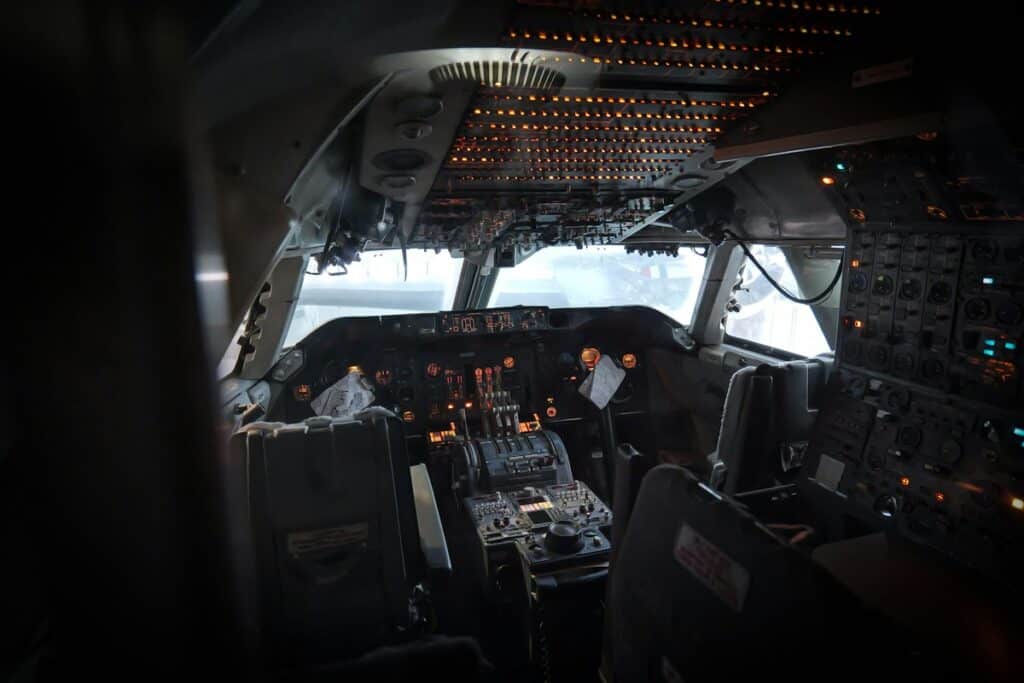
The startle response, often referred to as the “fight-or-flight” response, is an innate, automatic reaction that occurs when we perceive a sudden or unexpected threat or stimulus. It involves a rapid series of physiological and psychological changes designed to prepare the body for immediate action (or inaction in some cases).
This article delves into the “what and whys”, and more importantly, we share our thoughts on how to approach training in the startle response for both pilots and cabin crews.
Discover all our aviation-related topics.

The startle response, or a limbic hijack, is the body’s innate reaction to a sudden threat or stimuli. It involves various physiological and psychological changes aimed at ensuring our immediate survival.
Usually, the onset of the startle response is a startle reflex reaction. The startle reflex is a brainstem reflective reaction (reflex) that serves to protect vulnerable parts, such as the back of the neck (whole-body startle) and the eyes (eyeblink) and facilitates escape from sudden stimuli.
Put in simpler terms, if you’re suddenly face-to-face with a polar bear, your brain will go into “survival mode”; it will focus on directing blood and oxygen into your legs so that you can run as fast as possible away from the threat.
In aviation, a startle can occur as a reaction to a sudden, intense event incompatible with the pilot’s expectations.

Let’s pretend that you are one day confronted with a polar bear. You are running as if you were the new protagonist in the “Mission Impossible” franchise. How likely is it that in those moments of startle, you’ll start considering; did I once read an article that polar bears are poor climbers? And if that’s true, where would there be a place nearby that I could climb? I should call animal control – what’s their number again?
My guess is… highly unlikely.
Whenever we get startled, our logical, analytical thinking brain switches off and is “hijacked” by our limbic system – the part of our brain focused on survival, which in this present moment is RUN.
Now, put that example into aviation. While pilots are highly unlikely to ever face a polar bear midair, they face a whirlwind of other risks.
“… as aircraft become more reliable (…) pilots are surprised or startled by some event and, as a result, have either taken no action or alternatively taken the wrong action, which has created an undesired aircraft state, or in some cases, an accident. (…) The problem then is that the level of expectation of novel or critical events is so low that the level of surprise or startle that pilots encounter during such events is higher than they would have had some decades ago when things went routinely wrong.”
– Martin, Murray and Bates
The most significant concern when experiencing a startle stems from what the crew does or doesn’t do during the startle. Here, decision-making can be significantly impaired, especially higher-order functions necessary for making judgments about complex flight tasks.

Pilots often face unexpected and potentially life-threatening situations while in the air. Training can help them react swiftly and accurately when faced with critical emergencies, such as engine failure, severe turbulence, birdstrike, faulty instruments, or unexpected weather changes.
Training the startle response can include improving our reflexes, awareness, and physical readiness.
Pilots must make critical decisions under extreme stress. Training the startle response can improve their ability to think clearly and rationally during high-pressure situations, reducing the risk of panic-induced errors.
In-flight surprises or disorienting situations can lead to spatial disorientation, where pilots lose their sense of direction. Training the startle response can help pilots maintain their spatial awareness and keep control of the aircraft.
By honing their startle response, pilots can enhance their situational awareness, enabling them to quickly assess and respond to changing conditions and potential threats in the airspace.

Flight simulators are invaluable tools for pilot training. They expose pilots to various simulated emergency scenarios, helping them develop muscle memory and reflexes to respond effectively.
CRM training emphasises effective communication and teamwork among the flight crew. It equips pilots with the skills needed to manage high-stress situations collectively.
This training exposes pilots to controlled stressors, gradually increasing their ability to handle higher stress levels. It helps build resilience.
Pilots engage in ongoing education and recurrent training to stay up-to-date with the latest procedures, technologies, and safety protocols. This constant learning contributes to their ability to manage unexpected situations.
All the above methods are already well-used in the aviation industry. Yet, we still see accidents caused by inappropriate action due to the startle response.
So, what’s missing?
Here are my thoughts on how we must address the startle response in training in the future.
In 2016 as a speaker at the European Airline Training Symposium (EATS), I argued that there might be better alternatives than the training we use and rely on so heavily today.
Today, we aim to erase the risk of becoming startled by exposing crews to different possible events in flight simulators. However, crews receive little to no training in successfully managing a situation if they have not trained it in the flight simulator.
While ongoing training assists crews in managing a sudden and stressful event, it’s doubtful that any pilot or cabin crew will have trained to every possible scenario. In fact, it’s not doubtful – it’s impossible.
When we exclusively focus on simulator training to provide us with the necessary tools to withstand a startle, we risk that pilots fall into patterns they have seen before and are subject to several decision-making behavioural biases whenever an unusual or emergency situation occurs.
So, what happens when a sudden critical event occurs that might resemble something they have trained but does, in fact, require another course of action?
How well are we indeed training the startle response in pilots?
I would argue that effective training has nothing to do with training specific scenarios.
In its essence, a startle is a sudden emotional state that creates a reaction – unaccompanied by thoughts.
Although we agree that knowledge about the startle is instrumental, we question how much help knowledge will be to us if and when startled.
Training in the future for crews must be directed to deal with the emotional response caused by a startle rather than the exact situation itself.
Here’s a video of my presentation at EATS in 2016 explaining this further:
While we can all agree on what a startle is and its critical impact on flight safety, how we train crews to prevent getting startled differs.
At NaviMinds, we believe training specific scenarios is insufficient, as training every scenario is impossible.
Instead, we propose a new approach to the conventional training of the startle response that focuses on one’s emotional state of mind and how we may train this to be better at withstanding a possible startle.
Dive into our insightful and informative articles that will help you explore more and get ahead of the competition.
© 2024 NaviMinds – Designed by Aveo web&marketing